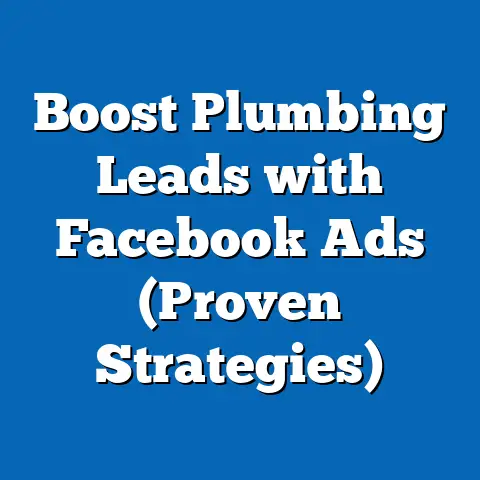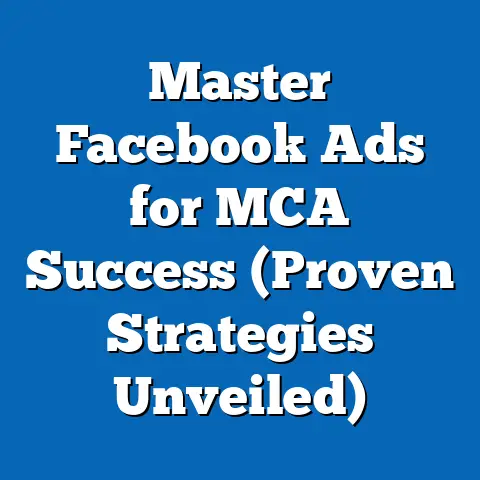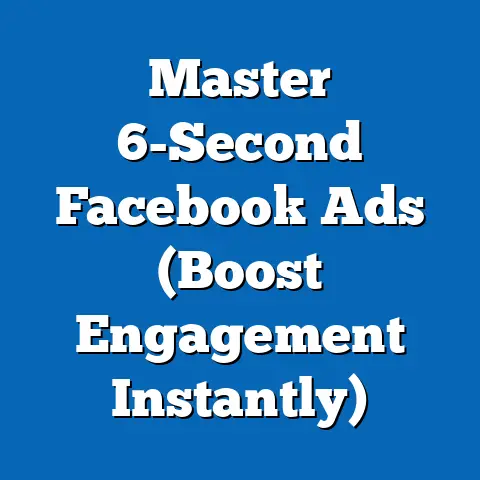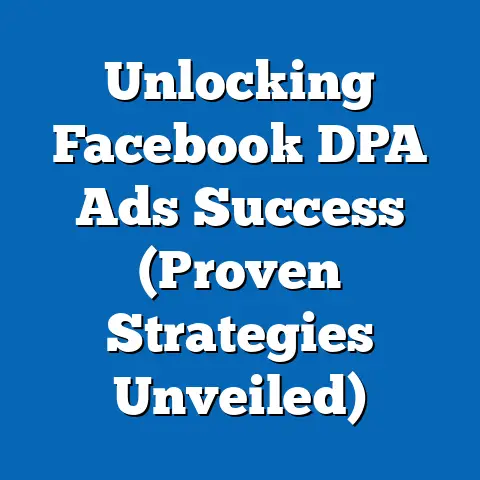Mastering Facebook Ad Spend (Proven Calculation Strategies)
Understanding Facebook Ad Spend
Let’s start with the basics. What exactly is Facebook ad spend? Simply put, it’s the amount of money you allocate to run your advertising campaigns on the Facebook platform. This includes everything from the creative assets (images, videos, copy) to the targeting parameters that determine who sees your ads. It’s the fuel that powers your campaigns and gets your message in front of your desired audience.
But why is it so crucial? Well, think of Facebook as a massive marketplace. Millions of businesses are vying for the attention of billions of users. Without a well-managed ad spend, your message risks getting lost in the noise. Effective ad spend management allows you to:
- Reach the right people: Targeted advertising ensures your message resonates with those most likely to convert.
- Maximize your ROI: By optimizing your campaigns, you can get the most bang for your buck.
- Scale your business: Successful advertising campaigns drive growth and help you achieve your business goals.
To truly grasp how to manage your ad spend, it’s important to understand the different pricing models Facebook offers. Here are the key components:
- Cost-Per-Click (CPC): You pay each time someone clicks on your ad. This is a good option if you’re focused on driving traffic to your website or landing page.
- Cost-Per-Impression (CPM): You pay for every 1,000 times your ad is shown (impressions), regardless of whether anyone clicks on it. CPM is often used for brand awareness campaigns where the goal is to get your brand in front of as many eyes as possible.
- Cost-Per-Acquisition (CPA): You pay only when a specific action, like a purchase or sign-up, is completed as a result of your ad. This is the holy grail for many advertisers, as it directly ties your spend to tangible results.
The specific cost for each of these models varies widely depending on factors like your target audience, the competitiveness of your industry, and the quality of your ads.
How Facebook’s Advertising Algorithm Impacts Ad Spend
Behind the scenes, Facebook’s advertising algorithm is constantly working to optimize ad delivery and ensure the best possible experience for both advertisers and users. Understanding how this algorithm works is crucial for managing your ad spend effectively.
The algorithm considers several factors when determining which ads to show to which users, including:
- Bid: The amount you’re willing to pay for a specific outcome (e.g., a click, an impression, a conversion).
- Relevance Score: A measure of how relevant your ad is to your target audience. Ads with higher relevance scores are generally favored by the algorithm and can result in lower costs.
- Estimated Action Rate: Facebook’s prediction of how likely users are to take the desired action after seeing your ad.
- Ad Quality: The overall quality of your ad creative and messaging.
The algorithm essentially runs an auction each time an ad opportunity arises. It evaluates all competing ads based on these factors and selects the one that it believes will deliver the most value to both the advertiser and the user.
Takeaway: Understanding the different pricing models and how Facebook’s algorithm works is the foundation for effective ad spend management. Keep these concepts in mind as we dive into specific calculation strategies.
Setting Clear Advertising Goals
Before you even think about crunching numbers and calculating budgets, you need to define your advertising goals. What do you want to achieve with your Facebook ads? Are you looking to increase brand awareness, generate leads, drive sales, or something else entirely?
Having well-defined goals is essential for several reasons:
- It provides direction: Goals give you a clear target to aim for and help you focus your efforts.
- It informs your strategy: Your goals will influence your targeting, ad creative, and bidding strategy.
- It allows you to measure success: Without clear goals, it’s impossible to determine whether your campaigns are actually working.
Here are some common advertising goals:
- Brand Awareness: Increasing the visibility and recognition of your brand among your target audience.
- Lead Generation: Collecting contact information from potential customers who are interested in your products or services.
- Website Traffic: Driving traffic to your website or landing page.
- Sales Conversion: Generating sales of your products or services directly through your ads.
- App Installs: Encouraging users to download and install your mobile app.
- Engagement: Increasing engagement with your Facebook page, such as likes, comments, and shares.
How Goals Influence Budget Allocation
Once you’ve defined your goals, you need to consider how they will influence your budget allocation. Different goals require different strategies and, therefore, different budget allocations.
For example, a brand awareness campaign might focus on reaching a large audience with a relatively low cost per impression (CPM). In contrast, a sales conversion campaign might focus on reaching a smaller, highly targeted audience with a higher cost per click (CPC) or cost per acquisition (CPA).
The table below illustrates how different advertising goals might influence budget allocation:
| Advertising Goal | Key Metric | Budget Allocation Strategy |
|---|---|---|
| Brand Awareness | CPM | Allocate a larger budget to reach a wider audience. |
| Lead Generation | Cost Per Lead (CPL) | Optimize targeting and ad creative to lower CPL. |
| Website Traffic | CPC | Focus on ad relevance and compelling calls to action. |
| Sales Conversion | ROAS | Prioritize campaigns with high ROAS and scale accordingly. |
| Advertising Goal | Key Metric | Budget Allocation Strategy |
|---|---|---|
| Brand Awareness | CPM | Allocate a larger budget to reach a wider audience. |
| Lead Generation | Cost Per Lead (CPL) | Optimize targeting and ad creative to lower CPL. |
| Website Traffic | CPC | Focus on ad relevance and compelling calls to action. |
| Sales Conversion | ROAS | Prioritize campaigns with high ROAS and scale accordingly. |
Takeaway: Clearly defining your advertising goals is the first step towards effective ad spend management. Your goals will guide your strategy and influence how you allocate your budget.
Calculating Your Ad Budget
Now, let’s get down to the nitty-gritty: calculating your ad budget. This is where things can get a little tricky, but don’t worry, I’ll break it down step-by-step.
There’s no one-size-fits-all formula for determining the perfect ad budget. It depends on a variety of factors, including your industry, target audience, goals, and existing marketing efforts. However, there are some proven strategies you can use to arrive at a reasonable and effective budget.
Determining Customer Lifetime Value (CLV)
One of the most powerful strategies for calculating your ad budget is to consider your Customer Lifetime Value (CLV). CLV represents the total revenue you expect to generate from a single customer over the course of their relationship with your business.
Understanding your CLV allows you to determine how much you can afford to spend to acquire a new customer. For example, if your CLV is $500, you might be willing to spend up to $100 to acquire a new customer, knowing that you’ll recoup that investment and generate a profit over time.
Calculating CLV can be complex, but here’s a simplified formula you can use:
CLV = (Average Purchase Value x Purchase Frequency) x Customer Lifespan
- Average Purchase Value: The average amount a customer spends each time they make a purchase.
- Purchase Frequency: The number of times a customer makes a purchase within a given period (e.g., per year).
- Customer Lifespan: The average length of time a customer remains a customer of your business.
Let’s say you run an online subscription box service. Your average purchase value is $50, your purchase frequency is 12 times per year (monthly subscription), and your average customer lifespan is 3 years. Your CLV would be:
CLV = ($50 x 12) x 3 = $1800
This means that, on average, each customer is worth $1800 to your business over their lifetime.
Calculating Return on Ad Spend (ROAS)
Another key metric for informing your budget decisions is Return on Ad Spend (ROAS). ROAS measures the revenue you generate for every dollar you spend on advertising.
The formula for calculating ROAS is:
ROAS = (Revenue Generated from Ads / Ad Spend) x 100%
For example, if you spend $1000 on Facebook ads and generate $5000 in revenue, your ROAS would be:
ROAS = ($5000 / $1000) x 100% = 500%
This means that for every dollar you spend on ads, you generate $5 in revenue.
A good ROAS will vary depending on your industry and business model, but generally, a ROAS of 300% or higher is considered healthy.
Using ROAS to inform your budget decisions involves setting a target ROAS and adjusting your ad spend accordingly. For example, if your target ROAS is 400% and your current ROAS is only 200%, you might need to optimize your campaigns to improve performance or reduce your ad spend.
Takeaway: Calculating your CLV and ROAS are essential for making informed budget decisions. These metrics provide valuable insights into the profitability of your advertising campaigns and help you determine how much you can afford to spend.
Monitoring and Adjusting Ad Spend
Setting your ad budget is just the first step. The real magic happens when you start monitoring your campaign performance and adjusting your ad spend based on the data you collect.
Continuous monitoring is crucial for several reasons:
- It allows you to identify what’s working and what’s not: By tracking key performance indicators (KPIs), you can see which campaigns are delivering results and which ones are underperforming.
- It helps you optimize your campaigns: Based on the data you collect, you can make adjustments to your targeting, ad creative, and bidding strategy to improve performance.
- It ensures you’re getting the most out of your budget: By continuously optimizing your campaigns, you can maximize your return on ad spend.
Key Performance Indicators (KPIs) to Track
Here are some key performance indicators (KPIs) you should be tracking:
- Click-Through Rate (CTR): The percentage of people who see your ad and click on it. A high CTR indicates that your ad is relevant and engaging to your target audience.
- Conversion Rate: The percentage of people who take the desired action (e.g., make a purchase, sign up for a newsletter) after clicking on your ad. A high conversion rate indicates that your landing page is effective and that your offer is compelling.
- Cost Per Click (CPC): The amount you pay each time someone clicks on your ad.
- Cost Per Acquisition (CPA): The amount you pay for each desired action (e.g., a purchase, a sign-up) that results from your ad.
- Ad Relevance Score: A measure of how relevant your ad is to your target audience. Ads with higher relevance scores are generally favored by the algorithm and can result in lower costs.
Strategies for Adjusting Ad Spend
Based on the data you collect, here are some strategies for adjusting your ad spend:
- Reallocate budget to high-performing ads: If you have multiple ads running, identify the ones that are performing best and allocate more of your budget to them.
- Pause underperforming campaigns: If a campaign is consistently underperforming, consider pausing it and re-evaluating your strategy.
- Adjust your targeting: If your ads are not reaching the right people, refine your targeting parameters to reach a more relevant audience.
- Optimize your ad creative: If your ads are not engaging your target audience, experiment with different images, videos, and copy.
- Adjust your bidding strategy: Experiment with different bidding strategies to optimize your cost per click or cost per acquisition.
Takeaway: Monitoring your campaign performance and adjusting your ad spend based on the data you collect is essential for maximizing your return on ad spend. Continuously analyze your KPIs and make adjustments to your strategy to improve performance.
Advanced Calculation Strategies
Once you’ve mastered the basics of ad spend management, you can start exploring some advanced calculation strategies to take your campaigns to the next level.
A/B Testing
A/B testing, also known as split testing, involves creating two or more versions of an ad and testing them against each other to see which one performs best. This is a powerful technique for optimizing your ad creative, targeting, and bidding strategy.
For example, you could test two different headlines, two different images, or two different calls to action. By tracking the performance of each version, you can identify the elements that resonate most with your target audience and optimize your ads accordingly.
Audience Segmentation
Audience segmentation involves dividing your target audience into smaller, more specific groups based on demographics, interests, behaviors, and other factors. This allows you to create more targeted ads that are more relevant to each segment.
For example, you could segment your audience based on age, gender, location, or interests. By creating ads that are tailored to each segment, you can improve your click-through rates, conversion rates, and overall return on ad spend.
Predictive Analytics
Predictive analytics uses statistical techniques to forecast future outcomes based on historical data. This can be a powerful tool for optimizing your ad spend and improving your campaign performance.
For example, you could use predictive analytics to forecast the likelihood of a user converting based on their demographics, interests, and behaviors. By targeting users who are most likely to convert, you can improve your conversion rates and reduce your cost per acquisition.
Takeaway: Advanced calculation strategies like A/B testing, audience segmentation, and predictive analytics can help you take your Facebook advertising campaigns to the next level. Experiment with these techniques to optimize your ad spend and improve your overall performance.
Case Studies and Real-Life Examples
Let’s take a look at some real-life examples of businesses that have successfully mastered their Facebook ad spend using the strategies we’ve discussed.
Case Study 1: E-commerce Startup
An e-commerce startup selling handmade jewelry was struggling to generate sales through their Facebook ads. They were spending a significant amount of money, but their return on ad spend was low.
After implementing the strategies we’ve discussed, they saw a dramatic improvement in their campaign performance. They started by defining their target audience more clearly and creating ads that were tailored to each segment. They also began A/B testing different ad creative and bidding strategies.
As a result, they were able to improve their click-through rates, conversion rates, and overall return on ad spend. Within a few months, they were generating a healthy profit from their Facebook ads and were able to scale their business.
Case Study 2: Local Restaurant
A local restaurant was looking to increase brand awareness and drive more traffic to their establishment. They were running Facebook ads, but they weren’t seeing the results they were hoping for.
After analyzing their campaign performance, they realized that their targeting was too broad and that their ads were not engaging their target audience. They decided to implement a more targeted approach, focusing on reaching people who lived near their restaurant and who were interested in dining out.
They also created ads that showcased their delicious food and highlighted their unique atmosphere. As a result, they were able to increase their brand awareness, drive more traffic to their restaurant, and generate more revenue.
Takeaway: These case studies demonstrate the power of mastering Facebook ad spend through proven calculation strategies. By implementing the techniques we’ve discussed, you can optimize your campaigns, improve your performance, and achieve your advertising goals.
Conclusion
Mastering Facebook ad spend is not a one-time task; it’s an ongoing process that requires continuous monitoring, analysis, and optimization. By understanding the fundamentals of ad spend, setting clear advertising goals, calculating your budget effectively, and implementing advanced strategies, you can transform your Facebook advertising from a cost center into a powerful engine for growth.
Remember, the key takeaways are:
- Define your goals: What do you want to achieve with your Facebook ads?
- Calculate your budget: How much can you afford to spend to acquire a new customer?
- Monitor your performance: What’s working and what’s not?
- Optimize your campaigns: How can you improve your click-through rates, conversion rates, and overall return on ad spend?
By implementing these strategies, you can maximize your advertising efforts on the platform and achieve your business goals. So, go forth, crunch those numbers, and unleash the power of data-driven Facebook advertising!






